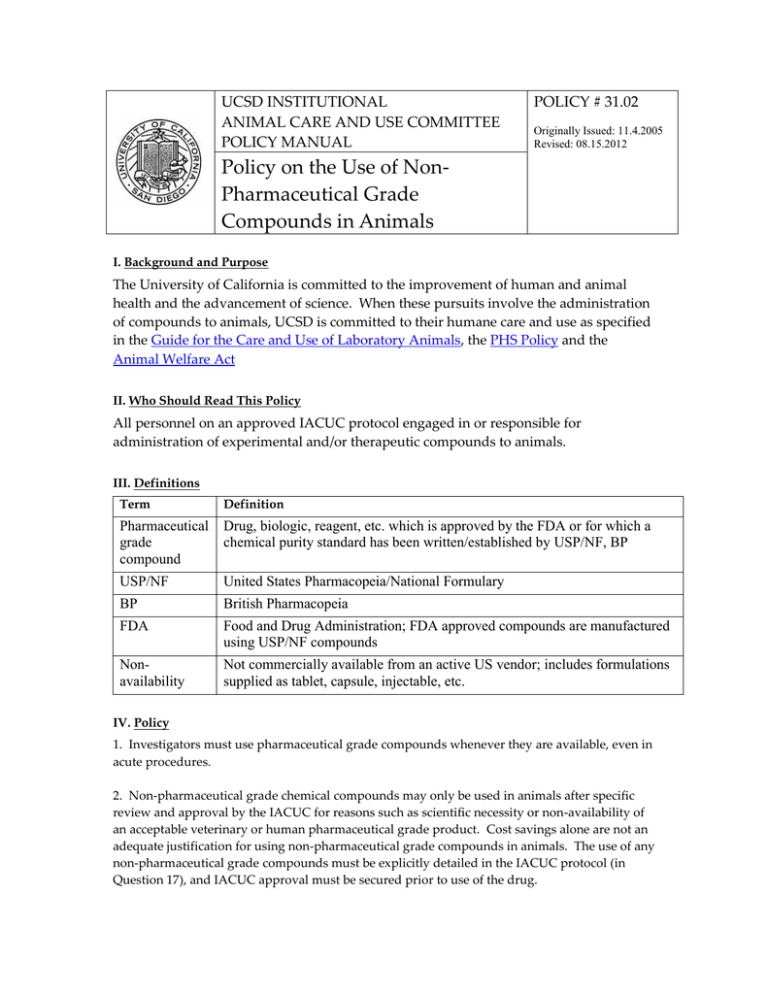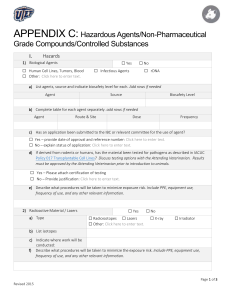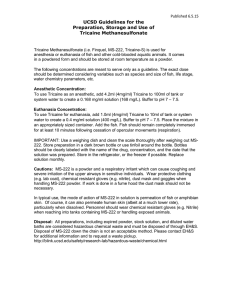Policy on the Use of Non- Pharmaceutical Grade Compounds in Animals
advertisement

UCSD INSTITUTIONAL ANIMAL CARE AND USE COMMITTEE POLICY MANUAL POLICY # 31.02 Originally Issued: 11.4.2005 Revised: 08.15.2012 Policy on the Use of NonPharmaceutical Grade Compounds in Animals I. Background and Purpose The University of California is committed to the improvement of human and animal health and the advancement of science. When these pursuits involve the administration of compounds to animals, UCSD is committed to their humane care and use as specified in the Guide for the Care and Use of Laboratory Animals, the PHS Policy and the Animal Welfare Act II. Who Should Read This Policy All personnel on an approved IACUC protocol engaged in or responsible for administration of experimental and/or therapeutic compounds to animals. III. Definitions Term Definition Pharmaceutical grade compound Drug, biologic, reagent, etc. which is approved by the FDA or for which a chemical purity standard has been written/established by USP/NF, BP USP/NF United States Pharmacopeia/National Formulary BP British Pharmacopeia FDA Food and Drug Administration; FDA approved compounds are manufactured using USP/NF compounds Nonavailability Not commercially available from an active US vendor; includes formulations supplied as tablet, capsule, injectable, etc. IV. Policy 1. Investigators must use pharmaceutical grade compounds whenever they are available, even in acute procedures. 2. Non-pharmaceutical grade chemical compounds may only be used in animals after specific review and approval by the IACUC for reasons such as scientific necessity or non-availability of an acceptable veterinary or human pharmaceutical grade product. Cost savings alone are not an adequate justification for using non-pharmaceutical grade compounds in animals. The use of any non-pharmaceutical grade compounds must be explicitly detailed in the IACUC protocol (in Question 17), and IACUC approval must be secured prior to use of the drug. 3. Prepared compounds must be labeled to include the name of the medication, the date the product is mixed, and expiration date of reconstituted compounds(s). Documentation of appropriate methods used to prepare and handle experimental compounds, taking into account pharmaceutical criteria such as sterility, shelf-life, and storage conditions, must be available to inspectors. Assistance in finding acceptable alternatives to non-pharmaceutical grade compounds is available from the veterinary staff of the Animal Care Program. V. Related Documents UCSD Documents Expired Medical Materials Anesthetic and Analgesic Dosages in Laboratory Animals Policy and Guidelines for Euthanasia Anesthesia Policy Other Documents and References Animal Welfare Act & Regulations The Guide for the Care and Use of Laboratory Animals AAALAC FAQ (yet to be published VI. Additional information 1. Understanding the difference between Therapeutic Compounds and Experimental Compounds Therapeutic compounds (anesthetics, analgesics, euthanasia agents, antibiotics, etc) almost always have pharmaceutical grade preparations available commercially. Federal mandates require the use of these pharmaceutical grade preparations. In the rare case that an appropriate therapeutic compound is not commercially available as pharmaceutical grade, the PI is responsible for preparing a sterile and physiologically-compatible preparation for use in animals. This preparation and storage must be described in the protocol and approved by the IACUC before use. Experimental compounds (test compounds) sometimes do not have pharmaceutical grade preparations available commercially. The PI is responsible for preparing a sterile and physiologically-compatible preparation for use in animals. This preparation and storage must be described in the protocol and approved by the IACUC before use. 2. Best Practices for Reconstituting Non-Pharmaceutical Grade Compounds If there is a scientific need to use a non-pharmaceutical grade compound and the UCSD IACUC has approved it in your protocol, the following guidelines should be followed: 1. Compounds must be sterilized prior to administration. The reconstituted compound may be sterilized by passing through a 0.2 μm filter. Diluents and solvents used for reconstitution should be pharmaceutical grade if possible. 2. Reconstituted compounds must be labeled identifying the compound, the date of preparation and the expiration date. 3. Reconstituted compounds should be discarded before degradation occurs. If degradation period is unknown, prepare compound fresh for each use. 4. Follow all manufacturer guidelines. 3. Guidelines for Use of Avertin: Tribromoethanol (Avertin) in Mice: Tribromoethanol is an injectable anesthetic agent used in mice. It was once manufactured specifically for use as an anesthetic by Winthrop Laboratories under the trade name Avertin, but this product is no longer available. Investigators who wish to use Tribromoethanol as an anesthetic must make their own solutions from a non-pharmaceutical grade chemical. Please note that this anesthetic cannot be used unless you have described it on your protocol, provided a scientific justification for using this anesthetic rather than a pharmaceutical-grade anesthetic, and received IACUC approval. The IACUC and the ACP veterinarians DO NOT RECOMMEND this anesthetic. Uses: Tribromoethanol is appropriate for short procedures in mice, especially surgical procedures. It's best used in situations where it will be given only on a single occasion. A repeat anesthetic episode can be associated with an increase in morbidity and mortality. Disadvantages of Avertin: Tribromoethanol is an irritant, especially at high doses, high concentrations, or with repeated use. Adhesions are sometimes seen in the abdominal cavity after IP injections. Tribromoethanol degrades in the presence of heat or light to produce toxic byproducts. Degraded solutions can be both nephrotoxic and hepatotoxic. Administration of degraded Tribromoethanol solutions has been associated with death, often 24 hours after surgery. Tribromoethanol can cause intestinal ileus resulting in a slowing of gut motility and subsequent death of the animal several weeks after injection. The effects of Tribromoethanol are also somewhat unpredictable in mice younger than 16 days, or in animals with altered carbohydrate metabolism, such as various mouse strains used for diabetes or obesity models (db/db mice or ob/ob mice). Chemicals: Two chemicals are necessary to imitate Avertin. The first is 2,2,2 Tribromoethanol; the second is amylene hydrate (tertiary amyl alcohol), both obtainable from Aldrich Chemical. There may be other sources as well. Compounding: Ingredients: o 2.5 gm 2,2,2 Tribromoethanol o 5 ml 2-methyl-2-butanol (amylene hydrate, tertiary amyl alcohol) o 200 ml distilled water - neutral pH Instructions: o Dissolve 2.5 grams Tribromoethanol in 5 ml amylene hydrate. This requires heating to approximately 40° Celsius and stirring vigorously. o Add distilled water, stirring continuously, up to a final volume of 200ml. o Filter through a Millipore filter (.2 micron) o Aliquot the final solution into appropriate containers - empty, sterile, red-cap blood collection tubes make a good receptacle, as do brown injection bottles with appropriate caps. It's often easiest to filter the material through a luer-fitted millipore filter directly into a sterile, red-cap blood collection tube. o Refrigerate the aliquots and protect them from light. The material degrades rapidly in the presence of heat or light. Even refrigerated and wrapped in foil, the material is stable for only about two weeks. If the material degrades, it becomes toxic. Many labs make a fresh batch for each use and even with this added precaution there can still be problems. o Tribromoethanol degrades to dibromoacetaldehyde and hydrobromic acid. If the pH of the solution is less than 5, it should be presumed to have degraded. o As prepared above, the solution contains 12.5 mg Tribromoethanol/ml. Do not attempt to make a more concentrated solution – the material is irritating at higher concentrations. o Label the vial with your initials, date prepared and expiration date (in 14 days). Cover with foil and refrigerate. Dosage - Use: Mix by swirling prior to administration. The material is given by IP injection at a dose of 250 mg/Kg. This amounts to 0.5 ml of the above solution to a 25gm mouse. Induction requires only 1-2 minutes and the righting reflex returns in approximately 40-90 minutes. Surgical anesthesia lasts for 15-45 minutes with a sleep time of 60-120 minutes. Cautions: Do not administer non-sterile solutions, outdated solutions, more concentrated solutions, or higher doses than recommended above. Store the solution under refrigeration and in the dark. Containers should be wrapped in foil. Replace refrigerated Avertin at least every 14 days. 4. Guidelines for preparation, storage and use of MS-222 (Tricaine): Tricaine Methanesulfonate (i.e. Finquel, MS-222, Tricaine-S) is used for anesthesia or euthanasia of fish and other cold-blooded aquatic animals. It comes in a powdered form and should be stored at room temperature as a powder. The following concentrations are meant to serve only as a guideline. The exact dose should be determined considering variables such as species and size of fish, life stage, water chemistry parameters, etc. Anesthetic Concentration: To use Tricaine as an anesthetic, add 4.2ml (4mg/ml) Tricaine to 100ml of tank or system water to create a 0.168 mg/ml solution (168 mg/L). Buffer to pH 7 – 7.5. Euthanasia Concentration: To use Tricaine for euthanasia, add 1.0ml (4mg/ml) Tricaine to 10ml of tank or system water to create a 0.4 mg/ml solution (400 mg/L). Buffer to pH 7 – 7.5. Place the mixture in an appropriately sized container. Add the fish. Fish should remain completely immersed for at least 10 minutes following cessation of opercular movements (respiration). IMPORTANT: Use a weighing dish and clean the scale thoroughly after weighing out MS-222. Store preparation in a dark brown bottle or use tinfoil around the bottle. Bottles should be clearly labeled with the name of the drug, concentration, and the date that the solution was prepared. Store in the refrigerator, or the freezer if possible. Replace solution monthly. Cautions: MS-222 is a powder and a respiratory irritant which can cause coughing and severe irritation of the upper airways in sensitive individuals. Wear protective clothing (e.g. lab coat), chemical resistant gloves (e.g. nitrile), dust mask and goggles when handling MS-222 powder. If work is done in a fume hood the dust mask should not be necessary. In typical use, the mode of action of MS-222 in solution is permeation of fish or amphibian skin. Of course, it can also permeate human skin (albeit at a much lower rate), particularly when dissolved. Personnel should wear chemical resistant gloves (e.g. Nitrile) when reaching into tanks containing MS-222 or handling exposed animals. Disposal: All preparations, including expired powder, stock solution, and diluted water baths are considered hazardous chemical waste and must be disposed of through EH&S. Disposal of MS-222 down the drain is not an acceptable method. Please contact EH&S for additional information and to request a waste pickup. http://blink.ucsd.edu/safety/research-lab/hazardous-waste/chemical.html 5. Guidelines for preparation, storage and use of Tamoxifen Note: Tamoxifen induction regimens should be determined empirically for the specific mouse lines and experimental setup involved. However, the following protocol provides a starting point for the induction of Cre in adult (P56) mice. The following procedure has been used with success to induce robust Cre activity in all major organ systems (validated in ubiquitous Cre /ER expressers, such as B6.Cg‐Tg(UBC‐cre/ERT2)1Ejb/J, JR#8085). Materials and Reagents: Tamoxifen (Sigma‐Aldrich), CAS # 10540‐29‐1 Corn Oil 70% Ethanol (for disinfection) 1 ml Syringe (BD) 3/8” beveled needle – 26 gauge (BD) Procedure: • Dissolve tamoxifen (Sigma‐Aldrich) in corn oil at a concentration of 20 mg/ml by shaking overnight at 37°C. Tamoxifen is light sensitive and should be made and stored in a light-blocking vessel (amber or foil wrapped). After tamoxifen is in solution, store at 4°C for the duration of injections. • Label the storage container with the date it is made • Throughout the course of tamoxifen injections and any post‐injection wait period, mice should be closely monitored for any adverse reactions to the treatment. Tamoxifen is a hazardous substance. Review the MSDS, wear appropriate PPE. Useful References: Madisen, L., et. al., Nat Neurosci. 2010; 13(1): 133–140 Sohal, D., et. al., Circ. Res. 2001; 89: 20‐25




